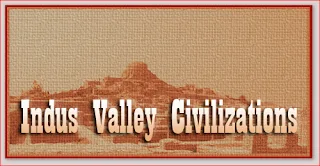In 1856, six miles from the river Ravi, in the foothills of the Himalaya, some railway construction workers came upon a small crumbling hill of fire-baked bricks. Along with the bricks, certain soapstone seals were found. Archaeologists quickly confirmed their antiquity. Thus started a voyage of amazing discovery during which archaeologists unearthed the remains of an ancient civilisation developed in the plains of the Indus River. The settlements were found as far west as Baluchistan in Pakistan and well down into the Gangetic Plains in India. The main cities of this civilisation were Mohenjo-daro and Harappa, both of which are in present-day Pakistan.
The Indus is one of the largest rivers in the Indian subcontinent. Remains of some old towns in the valley of the Indus River prove that a civilisation existed in this valley around 3000-1500 BCE. Indus Valley Civilisation was a highly developed urban civilisation. The first ruins of this civilisation were discovered at Harappa and Mohenjo-daro which were the two most important towns of this civilisation. The towns were properly planned and life was easy and comfortable. Let us take a look at a few things which made this civilisation a well developed urban civilisation.
Planned Township - The excavations at Mohenjo-daro and Harappa indicate that the towns were properly planned. A town was divided into two parts:
- A higher part which had public buildings, religious places and granaries.
- A lower part where the common man lived.
Houses - There were big as well as small houses. Some houses were single-storeyed while some were double-storeyed. They were built with bricks. They were properly plastered and painted. There were staircases leading to the roof of the houses. Most of the houses had courtyard, kitchen, bathroom and toilets irrespective of the size of the house. The doors of the house opened into a single courtyard. The windows opened up into the streets.
Food - The people of this civilisation used to grow various food crops like wheat, barley, peas, etc. They knew how to grind grains into flour and prepare chapattis from it. They ate fruits, vegetables as well as meat, eggs and fish.
Clothes - They also grew cotton and used it to make cotton clothes. They were expert in spinning and weaving the clothes. Apart from cotton clothes, they wore woollen clothes too. Both men and women wore simple robes of cotton or wool cloth, wrapped around their bodies with one shoulder bare. People were fond of jewellery made of shells, bones, silver, gold and ivory. They also had combs and head pieces to decorate their hair.
Means of Recreation - Toys made of clay have been recovered from these cities. They were in the shape of small carts, dolls, animals, birds, etc. The adults enjoyed themselves by singing, dancing, hunting, gambling and animal fights.
Religion - The seals, statues and pictures excavated from these places give us some idea about the religious faiths of the people who inhabited this civilisation. People in those times worshipped Mother Goddess, Lord Shiv and nature in different forms.
Trade - Agriculture, animal rearing, weaving and pottery were some of the main occupations of the people of the Indus Valley Civilisation. Some people made jewellery, utensils and tools from different metals. People traded their goods with each other in local markets. They also had trade with other neighbouring regions like Persian Gulf (now countries like Iran, Iraq, Kuwait, Saudi Arabia) and Afghanistan.
Fall of the Civilisation - The Indus Valley Civilisation flourished for about a thousand years. When the Aryans started migrating to India around 1500 BCE, this civilisation perished. The causes for its fall are not known. It could be due to the invasions or it could be due to natural causes like continuous floods, epidemics or changes in the climate.
End of Articles.... Thanks....


No comments:
Post a Comment